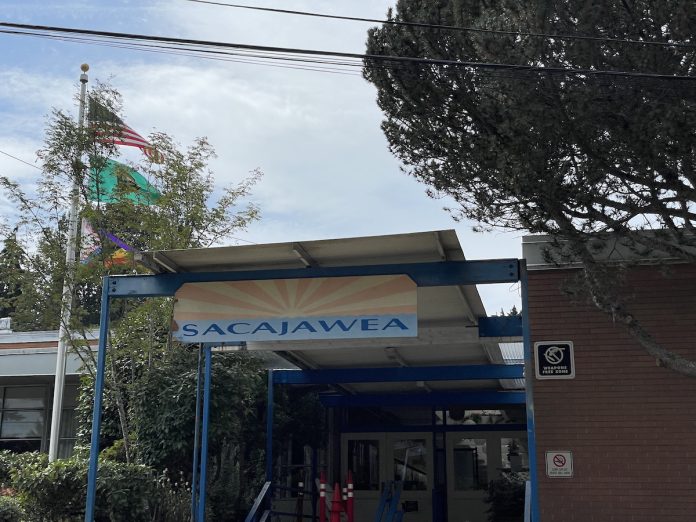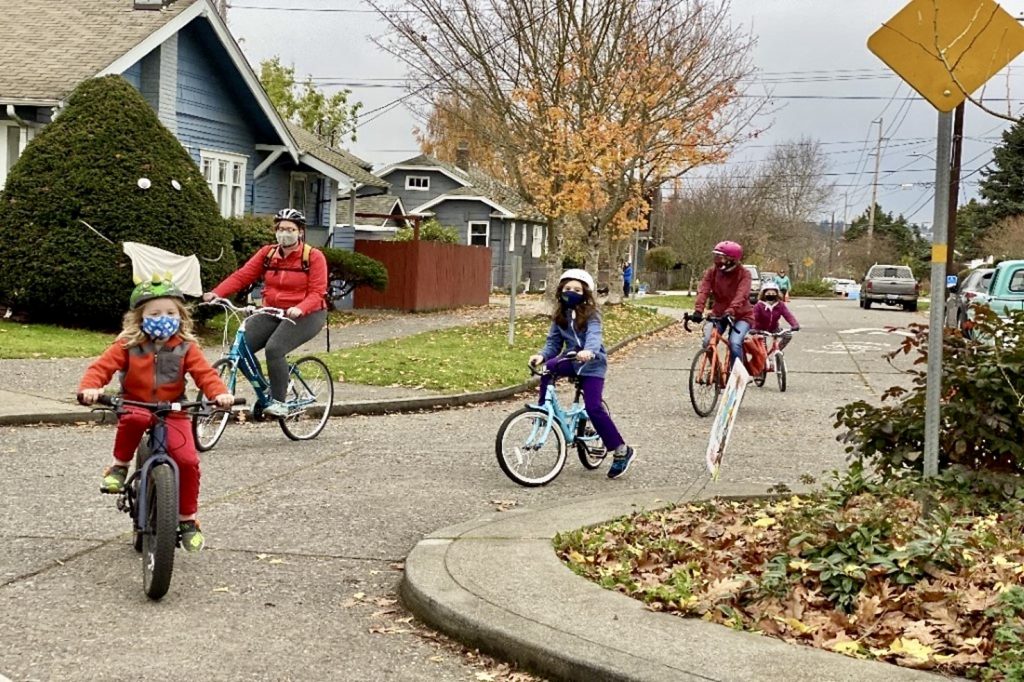
Seattle School Board director Liza Rankin is pushing a new round of austerity. Here’s why that’s off the mark.
Last week school board director and former school board president Liza Rankin wrote a memo to her colleagues proposing a major new round of austerity for the Seattle Public Schools (SPS). The proposal appears to revive a plan to close numerous public schools, as well as what she calls “strategic abandonment” of district functions.
Rankin’s proposal comes at a key turning point for SPS. The district is hiring a new superintendent, developing a new strategic plan, and voters are filling four of the seven seats on the school board in the November election. The memo is likely an attempt to influence those processes.
Like many other districts across the state, SPS faces ongoing budget deficits. Seattle voters, and many state legislators, prefer to solve it with a wealth tax. But Rankin’s memo envisions a lasting round of austerity that would come at the expense of Seattle’s students.
Seattle residents have shown their main priority for schools is improved academic rigor, not further austerity. Rebuilding public trust is also a priority. Some felt blindsided by the 2024 proposal to close 21 schools, which the district walked back after outcry.
In her recent memo, Rankin rules out increasing enrollment and raising new revenue as addressing the district’s financial issues. Instead, she appears to double down on the unpopular idea of a mass school closure — though she does shroud the idea in vague, sanitized management speak — think: “right-sizing.” (Rankin declined to answer emailed questions about her July 30 memo.)
Closures were never going to bring fiscal stability
Austerity is not new to Seattle Public Schools. District leaders have engaged in several rounds of budget cuts since the end of federal stimulus funding in 2022. Support staff and school administrators have been cut, along with some central office personnel. Class sizes have risen, especially in middle and high schools.
There’s no doubt SPS faces a deficit, as do many other districts across the state. The reason is not overspending or underenrollment. The cause is the state’s ongoing failure to amply fund our public schools as the state constitution requires. State Superintendent of Public Instruction Chris Reykdal has said schools are underfunded statewide by $4 billion per year.
Yet the actual size of SPS’s deficit has come under fire in recent independent analysis. SPS routinely projects an annual deficit of about $100 million. Community members have argued that the actual deficit size is likely less than $100 million, and found evidence that the district has failed to examine nearly $400 million in “district office” spending.
After having eliminated its fiscal committee earlier this decade (with Rankin’s support), limiting the board’s ability to monitor and even simply understand district spending, the school board recently announced the creation of an ad hoc budget committee. This committee will be chaired by board member Sarah Clark and includes Rankin and fellow board director Joe Mizrahi as members. The committee “is charged with making recommendations to the Board on budget development timeline, building trust in the budgeting process for Board and community, and scope of potential additional analysis of district finances.” It will help delve into these larger questions about the true state of SPS finances and its deficit.
SPS officials also began proposing permanent closures of schools. District leaders made it clear these were not proposed to save money or because of declining enrollment. SPS administrator Fred Podesta, who now serves as the district’s interim superintendent, said in early 2023 that closing schools is “a good strategy whether you have money problems or not.” In May 2024, Rankin herself acknowledged in a KUOW podcast that closing schools might not save money.
Mass school closures in other cities created a host of problems for students and schools without bringing the promised savings. Students whose schools closed had lower test scores, lower graduation rates, and higher dropout rates. Closures worsen enrollment declines, and fail to provide long term savings.
In Seattle, closing 21 schools would have saved only $30 million of a projected $100 million deficit – and that’s without including the cost to the district of lost enrollment from families who leave after their student’s school is closed. It would also have caused families to have to travel significantly longer distances to get their children to school, often beyond what is easy for kids to walk or bike. Since the proposal did not come with additional bus service, the result would have been more cars on the roads – especially near schools, undermining the city’s Safe Routes to Schools work.

In October 2024, SPS leaders proposed closing only four schools, which would have saved less than $1.5 million total. That plan was also abandoned in the face of opposition.
School enrollment fell in the early years of the 2020s. But that decline has leveled off since then, and began a slow rise in 2024. Enrollment remains higher now than it was during the 2000s, when SPS operated its current number of schools. Seattle’s overall population has continued to boom, passing the 800,000 mark, suggesting continued enrollment growth is possible.
A recent survey showed that the number of families choosing to enroll their kids in SPS dropped significantly between 2012 and 2023. The main reasons given by families were concerns about educational quality and changes to curriculum, suggesting SPS could win these families back.
Seattleites strongly opposed school closures. Thousands of people signed open letters against the closures, and hundreds of people showed up at mass rallies against the closures that were held in fall 2024. Polling commissioned in October 2024 by the Northwest Progressive Institute found voters were opposed to closures by a 2-1 margin (54% against closures, 27% for them).
Rankin was a strong supporter of those school closure plans. In 2023, Rankin argued for consolidating schools. When Superintendent Brent Jones cut the list of schools to be closed from 21 to 4 in early October 2024, Rankin told the Seattle Times “the district needs to close more than five schools over time.” In April 2025, she told the Times “It seems fiscally irresponsible to me to maintain the level of capacity that we have.” Rankin’s memo then is just the latest step in her effort to justify a mass school closure, despite public opposition.
“Right-sizing” and “strategic abandonment”
Rankin’s memo does not focus on ways to grow enrollment or bring new resources to SPS. Instead, it focuses on ways to make cuts, with a particular emphasis on what she calls “right-sizing” – another term for closing schools.
She lays out how a new closure process ought to unfold:
“The Superintendent’s process for right-sizing should differentiate between school effectiveness, facility quality/condition, and facility affordability, and should carefully distinguish between a building, a school community, and a program, when recommending moves/changes. A sizeable community committee with representative voices is essential.”
While this provides more detail than the vague justifications given for the 2024 closures, this still envisions a potentially sizable closure process in which schools with low test scores are closed, rather than given additional resources. This would repeat Chicago’s devastating school closure experience. It also lets the district off the hook for failing to address student learning needs, instead blaming the students and families whose schools they close for lacking “effectiveness.”
Although having a “sizable community committee with representative voices” is a good idea for any major district proposal, it does not reduce the harmful impacts to students, families, and communities of a mass school closure. When the public opposed closures in 2024, they were not asking for a different process. They were opposing the closures themselves.
A new round of school closures is just one of the possible aspects of Rankin’s wider austerity plan. Her memo also suggests SPS cease other programs and services as part of what Rankin terms a process of strategic abandonment: “Strategic abandonment is essential. It’s just as important to get clear about what the school system will stop doing as it is to get clear about what it will start doing or continue.”
Rankin does not provide details of what SPS would abandon, but other school districts around the country have stopped offering arts, music, athletics, libraries, and other core services as part of their own “strategic abandonment” plans. The only specific thing her memo proposes could be abandoned are school buildings.
Undermining the push for a wealth tax
Rankin’s proposals amount to waving the white flag in the battle to fix Washington State’s upside down tax code and pass a wealth tax to fund public education. As she wrote in her memo, “We are out of options and cannot afford magical thinking – no imaginary new funds, new taxes, grants, no sudden increase of student enrollment.”
But there are significant new funds and new taxes on the horizon, particularly a wealth tax. Rankin’s austerity plan could, if implemented, undermine the effort to pass a wealth tax at the state level – an effort that showed increased strength in the 2025 legislative session — though it ultimately came up short.
The “wealth tax” is a common name for a financial intangibles tax. In the 2025 session, the entire State Senate Democratic caucus proposed a financial intangibles tax that would have generated $4 billion per year for public schools. According to the caucus, the proposed revenue source would be “a tax of $10 on every $1,000 of assessed value of certain financial assets (stocks, bonds, exchange-traded funds, and mutual funds) held by individuals with more than $50 million of these assets, paid by about 4,300 wealthy individuals.”
Senate Democrats’ proposal also had strong support among many House Democrats. But it lacked support from Governor Bob Ferguson, and failed to pass the legislature in the 2025 session. Supporters vowed to continue the effort in future years.
The wealth tax does have very strong support from the public. An October 2024 poll by the Seattle Times found 66% of voters support a wealth tax. The same poll also found that 65% of voters want to spend at least $3 billion a year in additional funding for public schools, which the Senate Democrats’ wealth tax would have achieved.
Opponents of taxing the rich and big corporations often call instead for governments to cut spending. In Seattle, Council President Sara Nelson, the Seattle Metropolitan Chamber of Commerce, and the Seattle Times Editorial Board often call for sweeping spending cuts to city services as an alternative to City Hall passing new progressive revenue measures.
If SPS and other school districts across the state embrace austerity plans, closing schools and scaling back services, this could reduce pressure on legislators to pass a wealth tax. Tax averse Democratic and Republican legislators, as well as corporate lobbyists and wealthy individuals, could point to “right-sizing” and “strategic abandonment” at public schools as viable alternatives to a wealth tax. In my own experience, legislators from both parties are often eager to find alternatives to raising taxes for public education.
Rather than give up the fight for a wealth tax and embrace austerity in our public schools, Seattle’s elected leaders ought to double down on the wealth tax and other progressive revenues in the legislature – especially as the impact of Trump’s economic policies further erodes funding for schools and other public services.
Conclusion
Rankin’s memo and the sweeping austerity that it floats ought to become a central topic of discussion and debate during the hiring of a new superintendent, as well as in the fall school board election campaigns. Candidates should be asked whether they would support or oppose a new school closure effort or “strategic abandonment” of district programs and services.
Rather than embrace austerity, SPS should let the new ad hoc budget committee do its work, and make financial decisions based on the community’s stated priorities, which do not include closing schools. And all of us, including school board directors, ought to turn up the pressure on Olympia to amply fund our public schools with a wealth tax.

Robert Cruickshank
Robert is the Director of Digital Strategy at California YIMBY and Chair of Sierra Club Seattle. A long time communications and political strategist, he was Senior Communications Advisor to Seattle Mayor Mike McGinn from 2011-2013.
